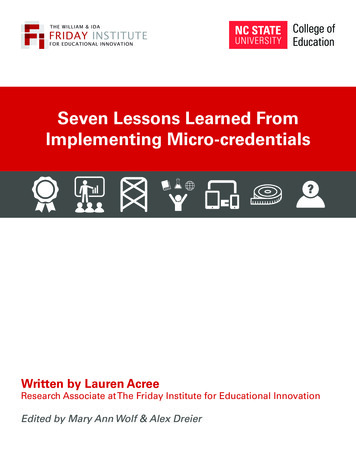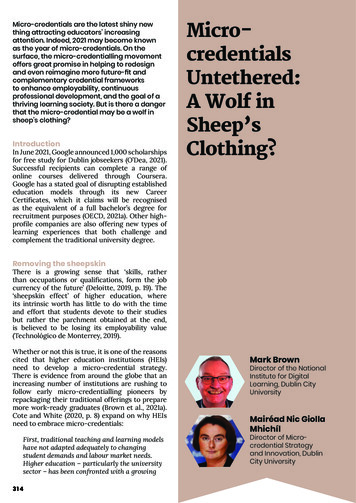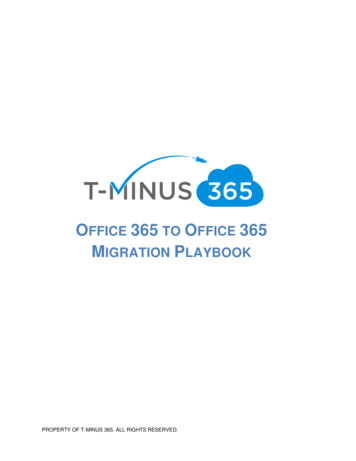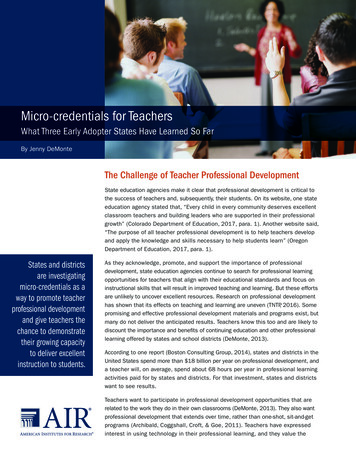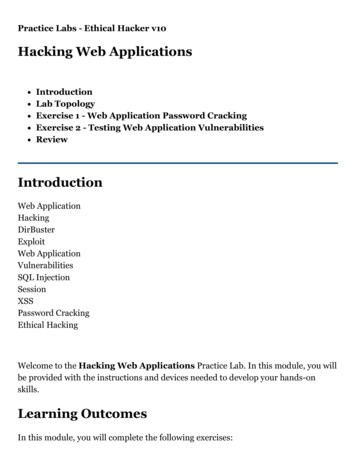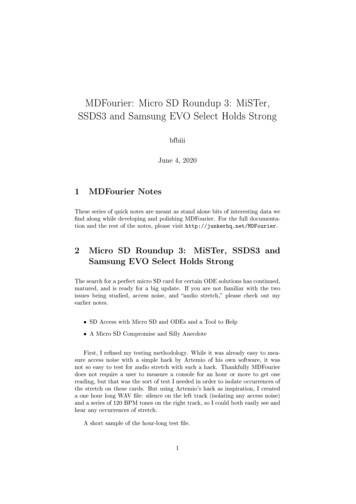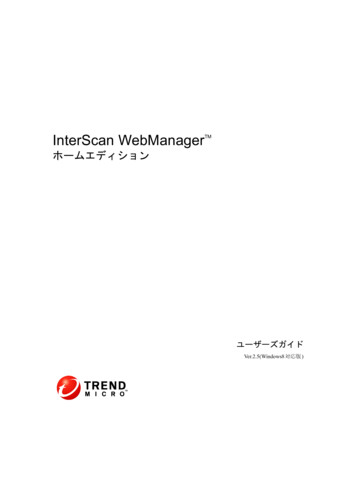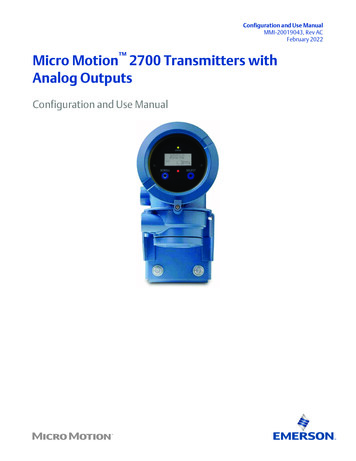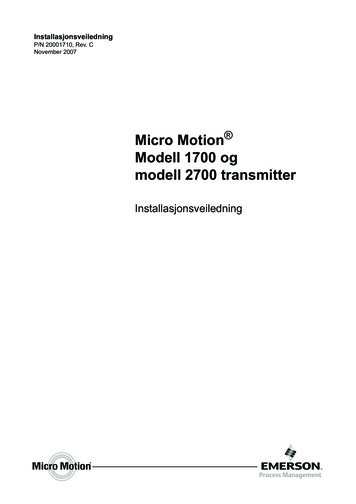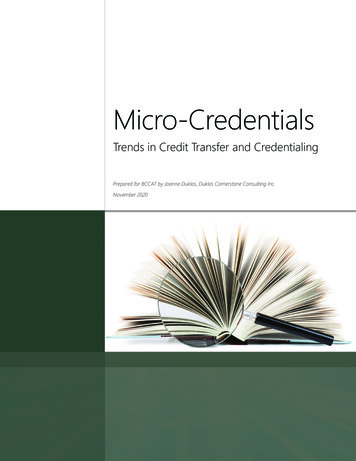
Transcription
Micro-CredentialsTrends in Credit Transfer and CredentialingPrepared for BCCAT by Joanne Duklas, Duklas Cornerstone Consulting Inc.November 2020
Micro-CredentialsTrends in Credit Transfer and CredentialingPrepared for BCCAT by Joanne Duklas, Duklas Cornerstone Consulting Inc. BCCAT November 2020BC COUNCIL ON ADMISSIONS & TRANSFERWeb/Email: bccat.ca bctransferguide.ca info@bccat.caTwitter: @bccat org @bctransferguide
AcknowledgementsThe researcher extends thanks to the following individuals who lent their insights and expertise to this project.Simone Ravaioli, Director, Strategic Partnerships, DigitaryAndy Kisby, Director, PG Dip Bus & Admin Employability, Otago Polytechnic, New ZealandDr. David Porter, Dean of Innovative Learning and Senior Special Advisor for Flexible Learning, Humber College Polytechnic,CanadaDon Presant, Chief Development Officer, CanCred.ca; president, Learning AgentsDr. Rajiv Jhangiani, Associate Vice Provost, Open Education, Kwantlen Polytechnic University, CanadaLena Patterson, Co Executive Director (Interim), eCampusOntarioNaza Ddjafaro, Director, Digital Education Strategies, G. Raymond Chang School of Continuing Education, Ryerson UniversityAnnik Gélineau, Registraire adjoint, Université de MontréalPeter Gooch, Consultant and former Senior Director, Policy and Analysis, Council of Ontario UniversitiesAppreciation is also extended to Anna Foshay, Blossom Consulting, who supported the early research for the project,including the development of the survey instrument.
Table of Contents E XECUTIVE SUMMARY 1 I NTRODUCTION 4 R EPORT DEFINITIONS 5 R ESEARCH APPROACH 6 F INDINGS 7Micro-credentials: Exploring the Definitional Variety 7Micro-credentials and Digitization 13Exploring the Quality of Micro-Credentials 14Current and Emerging Exemplars of Micro-Credentials 16Canadian Examples: 16International Examples 18Portability and Technology 19Survey and Interview Findings 22Survey Respondent Cohort 21Micro-Credential Providers 23Definitions and Nomenclature 23Defining Characteristics of Micro-Credentials 25Learning Experience Being Credentialed 27Motivations for Developing Micro-Credentials 28Micro-Credentialing Source 29Approval Authority for Micro-Credentials 30Considering Micro-Credentials for Admission or Transfer 31Transcription Practices 31Exploring the Human Resources Specialists’ Perspectives 32Overarching Considerations 34Suggestions for Additional Research 35 M OVING FORWARD 36Establishing Shared Definitions 36Aligning Micro-credentials with Existing Quality Assurance Processes and Contexts 37Creating a Credential Registry 37Establishing Industry Partnerships 37Aligning Micro-credentials with Existing Recognition of Prior Learning Processes 37Creating Communities of Practice 38Implementation Checklist 39 F INAL CONCLUDING REMARKS 40 B IBLIOGRAPHY 42 A PPENDIX A: DEFINITIONS FOR MICRO-CREDENTIALS 464 BCCATMicro-Credentials
List of Tables TABLE 1: Defining Characteristics of Micro-credentials 11 TABLE 2: Type of Learning being Credentialed 12List of Figures F IGURE 1: Vertical Stacking 8 F IGURE 2: Horizontal Stacking 8 F IGURE 3: Complementary Stacking 9 F IGURE 4: A Sample of National Level Credential Exchange and Validation Service Providers in Higher Education 14 F IGURE 5: Example of Decision Milestones Impacting Micro-Credentials - Post-secondary Admission and Transfer 15 F IGURE 6: Geographical Diversity of Respondents by Percent (n 90) 22 F IGURE 7: Types of Organizations Represented in the Survey by Percent (n 90) 22 F IGURE 8: Percentage of Respondents from Institutions with or without a Working Definition for Micro-credentialsby Organization Type (n 90) 23 F IGURE 9: Terminology Used to Describe Micro-credentials at Post-Secondary Institutions by Percentage (n 18) 29 F IGURE 10: Micro-credentialing Terminology in Use by Institutional Type and Percentage (n 18) 25 F IGURE 12: Defining Characteristics of Micro-credentials by Institution Type and Percent (n 18) 26 F IGURE 13: Learning Experiences Credentialed in a Micro-credential (n 18) 27 F IGURE 14: Motivations for Offering Micro-credentials (n 19) 29 F IGURE 15: Departments within a Post-Secondary Institution that Oversee Awarding Micro-credentials (n 18) 30 F IGURE 16: Internal Approval Authority for Micro-credentials, Percentage of Respondents (n 18) 31 F IGURE 17: Micro-credentialing Awarded to Employees by Organizations, Percentage of Respondents (n 90) 32 F IGURE 18: Plans to Adopt Micro-credentials, Percentage of Respondents (n 90) 34BCCAT 5
Executive SummaryA plethora of micro-credentialing research and pilots are underway across Canada and around the world led by academicresearchers, government, and industry. The intensity is creating a perfect storm of opportunity that is reframing assessmentpractices. Exploring their utility for admission and transfer into higher education, the focus of this study, represents a gap in theresearch.Four objectives defined the scope of this research:1. Identifying and reviewing current and emerging practices in developing and accepting micro-credentials in admissions andtransfer in British Columbia and elsewhere;2. Assessing institutional perspectives on motivations, issues, and opportunities for developing and using micro-credentials foradmissions and transfer at post-secondary institutions in BC, Canada and beyond;3. Exploring employers’/ human resources staff perspectives on micro-credentials in the labour market, to the extentinformation was available and accessible; and4. Identifying areas for future research and, if appropriate, the development of practices.The report provides insights into current micro-credentialing practices, motivations, and perspectives at Canadian higher educationinstitutions and beyond. The research approach included conducting eight interviews with higher education micro-credentialingexperts, including those situated within Canadian post-secondary institutions; a national, bilingual survey that had a 90% responserate with 90 participants; and an environmental scan of the literature and web information for micro-credentials.NomenclatureDefining micro-credentials became an early challenge in the project. The literature review and environmental scan provided insightinto this variety and identified some consistent themes. The many different forms of micro-credentials create further confusion(e.g., badges, certificates, e-portfolios, tokens). As imprecise nomenclature can be an impediment to achieving clarity, surveyand interview questions explored participants’ perspectives and examples of defining characteristics and definitions for microcredentials.The report lists examples of micro-credential definitions from Canada and beyond, and suggests specific, more aligned definitions.At their core, micro-credentials provide validated evidence of what a person knows and can do in a focus area, skill, or competencyat a granular level; these credentials tend to be very specific to purpose (e.g., to aid access and transition to the workforce in aparticular industry).Assessing and Transcripting Micro-CredentialsAs a relatively new concept for Canadian post-secondary institutions, accessing transcript examples for micro-credentials provedto be a challenge. Unfortunately, only one was provided; however, this was supplemented by survey questions about transcriptionpractices. The study results indicated that most of these credentials were awarded through continuing education departmentsand thus outside of student information systems or at the program level such as through or outside of learning managementsystems. Most are disconnected from the regular institution wide, quality assured credentialing framework and enterprise levelstudent record systems. Institutions do transcript courses which may be part of the learning that led to a micro-credential. However,most admission and transfer credit assessment processes appear blind to whether a student or applicant presented a microcredential. As the source and the quality assurance context for these micro-credentials tend to be ambiguous or not well known,credential evaluators (including faculty) appear to disregard them when assessing admissions and transfer credit for post-secondaryconsideration. The study did find examples of institutions that do grant admission and transfer for micro-credentials but thepractice is not wide-spread.1 BCCATMicro-Credentials
When micro-credentials represent learning that is transcripted (e.g., as courses), they could be used for admissions or transfer byCanadian post-secondary institutions. Some institutions referenced existing certificate programs and suggested these, once credentialed,represent a form of micro-credentialing of formal learning. As these tend to be part of approved, quality assured programs, thesecould be and likely are used by institutions to support admission and transfer assessment, if the learning is represented explicitly on thetranscript.Purposes of Creating Micro-CredentialsThe most common intentions for creating micro-credentials involve providing credentialed recognition for what a person knows and cando at a modular level. Typically, the qualification is designed to present a recognized and official symbol of the learning experience toenhance access to and within the workplace.While our survey identified “access to future studies” as the top motivation for developing micro-credentials, it was not supported bysignificant evidence of micro-credentials being used in transfer and admission processes. There was no evidence of a strong connectionto motivations focused on designing these credentials to support future admission, transfer, and stackability. This suggests a missedopportunity and an area ripe for future development.Interviewees and survey respondents indicated that micro-credentials represented an opportunity to enhance prior learning assessmentpractices for admission and potentially even transfer and saw the potential for micro-credentials to enhance recognition and scalableassessment of prior learning.Exemplars of Micro-CredentialingThe report provides several examples both within Canada and internationally of promising practices in the field of micro-credentialing.As this research focused on admission and transfer, notable Canadian exemplars include Thompson River University’s recent innovationwith micro-courses in support of the Open Education Resource universitas (OERu),1 Simon Fraser’s FASS Forward microcredit courses,2Algonquin College’s Micro-credentials Framework,3 and the New Zealand Qualifications Authority’s work to systematize and embedmicro-credentials into the country’s quality assurance framework.4 The latter, along with the US-based Credential Engine’s5 online registryprovide scalable, system level mechanisms for supporting the quality assurance credential ecosystem. eCampusOntario’s work to supportpilot projects in Ontario (emphasizing the importance of transcription as part of its framework), serves as a helpful system level examplethat is incentivizing change.6 The State University of New York’s robust definition for micro-credentials stands out for its nuanced qualityconsiderations, a necessary antecedent for successful adoption of these credentials in admission and transfer processes.7Institutional PerspectivesOne quarter (22%, 18 of the 81 institutional respondents) of survey respondents indicated they were exploring micro-credentials. In someinstances, these respondents currently award admission and transfer credit. A subset of respondents do so primarily to facilitate transitionto and within the workplace or to recognize competencies achieved through co-curricular experiences. Some seek to use microcredentials to evidence skills and competency beyond learning that is captured in traditional diplomas and transcripts. Micro-credentialssuch as digital badges are also offered to students to highlight focused learning achieved through their program that is of relevance totheir field of study. Continuing education departments at Canadian post-secondary institutions appear to be leading the way with microcredentialing and, in many instances, are establishing alternative partnerships with industry, sometimes aided by government airs/microcredentials/8The government funded eCampusOntario projects represent recent examples of these types of initiatives.BCCAT 2
DigitizationThe study reveals that micro-credentials are available in both digitized and non-digitized formats. However, digitization representsa growing area of interest. Some of those interviewed were embracing blockchain as the potential solution to support accessible,just-in-time access for learners to their micro-credentials. With advances in technology and mainstream digitization of all manner ofparchments and documents in higher education that leverage blockchain and data exchange models, digitization has become thenew baseline for portability, access, and self-sovereign credentials. As such, it is no longer exclusive to micro-credentials.Employer PerspectivesThe researchers explored the extent to which institutions distribute micro-credentials to their own employees and faculty/courseinstructors and whether these same institutions use these during their own admission and transfer assessment processes. Theresearchers found some examples where micro-credentials were awarded to institutional employees; however, the data findingswere too small to support robust analysis for admission and transfer. This represents an area of future research.Additional ResearchThere have been several research and consultation projects underway or planned in Canada to better understand microcredentials. Samples included exploring how they fit into the higher education credentialing context and qualifications frameworks;what type of learning should be represented; how to evolve campus capacities to create and deliver micro-credentials (Presant,2020); how they should be defined (see Appendix A for examples); what principles should guide their development and who shouldestablish these principles; and what role, if any, government should play to incentivize usage. Several future research topics aresuggested along with a recommendation that they be explored at a national scale:1. How closely are existing micro-credentials tied to established educational quality assurance procedures for programdevelopment, delivery, and review? Should they be, or in what circumstances should they be, and would this represent adistinguishing factor to aid their utility for admission, transfer, and stackability?2. What might be the implications of expansion of existing credential frameworks to include micro-credentials? Is thisnecessary in order to advance adoption of micro-credentials for admission and transfer assessment processes?3. Where is responsibility and stewardship of micro-credentials situated within higher education organizations, and what arethe implications of different approaches for transcription, admission, transfer, and stackability of the credentials?Final ThoughtsExamining micro-credentials through the lens of admission and transfer suggested that an opportunity exists to focus motivationsand ensure that the purpose of providing access is clearly articulated, even in the design stage. Embedding a focus on admissionand transfer from the outset represents an opportunity for micro-credentials. The practice of admission and transfer assessmentis heavily informed by best practice considerations, conventions, and quality assured metrics. If a micro-credential is to be usedeffectively for mainstream adoption in admission and transfer assessment, important questions need to be asked and answered.These processes typically demand information on which institution or organization delivered the credential, the supporting qualityassured process, what assessments were used, etc. The report provides several examples to support future next steps for microcredentials.Micro-credentials can and should contribute to admission and transfer, but doing so requires focus, quality assurance, andintentional design that considers access pathways to future studies. System level support can be an enabler to encourage adoptioninto mainstream assessment practice. An implementation checklist for micro-credential design is provided in this report.3 BCCATMicro-Credentials
IntroductionInterest in micro-credentials is growing rapidly in Canadian higher education, in concert with a desire to find new methods fordelivering, assessing, and credentialing skills and competencies. This interest, incentivized in part by institutional mandate, as wellas government and industry funding, has driven several micro-credentialing projects already underway across Canada. Recognizedpost-secondary institutions are separately or in partnership with industry, providing learning experiences and subsequentcredentials that represent a subset of formal recognized learning, learning offered through continuing education departments atpost-secondary institutions (i.e., not necessarily recognized for transfer credit and admissions into post-secondary studies), andintentional workplace learning.9 At times, the credentialed experiences straddle two or more of these learning opportunities.There is a strongly held perception that diplomas and transcripts lack the capacity to represent the breadth and depth of learningprovided in and beyond post-secondary institutions. Canadian higher education institutions offering or exploring micro-credentialsappear to focus primarily on those credentials that facilitate transition to and within the workplace. Continuing educationdepartments at these institutions appear to be leading the way in the micro-credentialing field to advance recognition received,either through their own programming or through industry partnerships.Informed by this context and with the support of funding from the British Columbia Council on Admissions and Transfer (BCCAT),the researchers explored if and how micro-credentials might enable admission and transfer into Canadian post-secondaryinstitutions, a current gap in the research.The following objectives informed the research:101. To identify and review current and emerging practices in developing and accepting micro-credentials in admission andtransfer in British Columbia and elsewhere;2. To assess institutional perspectives on motivations, issues, and opportunities for developing and using micro-credentials foradmission and transfer at Canadian post-secondary institutions;3. To explore human resource perspectives on the use of micro-credentials in the labour market (assuming availableinformation);4. To identify areas for future research and, if appropriate, the development of future practices.9Terms such as recognized learning or recognized post-secondary institution, formal recognized learning, informal learning, and intentional workplace learning have specific meaning in this report and are explained in the section ‘Report Definitions’ below.10It is important to stress that the scope of this research focused primarily on those micro-credentialing opportunities that improve access topost-secondary studies through admission and transfer. The researchers did not seek to examine the full range of micro-credentialing opportunitiesand definitions although some details are provided to aid context setting.BCCAT 4
Report DefinitionsThe following terms have specific meaning in this report and are provided to aid interpretation of the findings.Formal Educational Learning/Formal Learning – learning in a recognized institution that is organized, structured, and supportedby learning objectives (OECD, 2019). In the context of this research, formal learning is further defined as learning that leads to aqualification awarded by an educational institution (e.g., a baccalaureate degree or college diploma) (Duklas et al., 2015).Informal Learning – unorganized and unintentional learning received from experiences with no established learning outcomes(OECD, 2019). For this research, informal learning includes knowledge gained from life and work experiences outside of structuredlearning contexts (Duklas et al., 2015).Non-formal Learning – somewhat organized learning that may have learning objectives (OECD, 2019).Intentional Workplace Learning – organized structured learning in the workplace that may lead to a credential (Duklas et al.,2015).Digital badge – a visual representation of a credential that is displayed and verified online. A digital badge might also representother forms of achievement. When the badge is clicked on, a page will pop up that will typically explain what the badge represents,how it is earned, and so forth. (Association Trends, 2018)Recognized Post-Secondary Institutions – an academic institution that is granted the [authority] to award academic credentials(e.g., certificates, diplomas, degrees) by a provincial or territorial government in Canada such as through formal legislative act andthat is subject to quality assurance expectations and subsequent review as appropriate to institutional type, sector, and jurisdiction.It includes institutions such as universities, CEGEPs, institutes, colleges (Duklas & Pesaro, 2015).Micro-Credential - a qualification that represents assessed achievement of a subset of learning within and beyond the traditionalrealm of certificates, diplomas, and degrees. These provide credential recognition for what a person knows and can do at a modularlevel. The learning experience can occur within a recognized post-secondary program, in the workplace, in other settings, or bea blend of two or more of these. Typically, the qualification is intended to present a recognized and official symbol of the assessedlearning experience to enhance access to and within the workplace. More details on this definition are contained below.Stackable credential - a credential that is part of a learning sequence that can be accumulated over time to build up an individual’squalifications and help that individual move along a career pa
A plethora of micro-credentialing research and pilots are underway across Canada and around the world led by academic . The government funded eCampusOntario projects represent recent examples of these types of initiatives. 3 Micro-Credentials BCCAT. Digitization. The study reveals that micro-credentials are available in both digitized and non .
